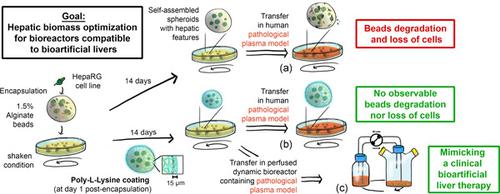当前位置:
X-MOL 学术
›
Biotechnol. Bioeng.
›
论文详情
Our official English website, www.x-mol.net, welcomes your
feedback! (Note: you will need to create a separate account there.)
Preclinical characterization of alginate‐poly‐L‐lysine encapsulated HepaRG for extracorporeal liver supply
Biotechnology and Bioengineering ( IF 3.5 ) Pub Date : 2020-09-30 , DOI: 10.1002/bit.27583 Mattia Pasqua 1 , Ulysse Pereira 1 , Claire de Lartigue 1 , Jonathan Nicolas 1 , Pascale Vigneron 1 , Quentin Dermigny 1 , Cécile Legallais 1, 2
Biotechnology and Bioengineering ( IF 3.5 ) Pub Date : 2020-09-30 , DOI: 10.1002/bit.27583 Mattia Pasqua 1 , Ulysse Pereira 1 , Claire de Lartigue 1 , Jonathan Nicolas 1 , Pascale Vigneron 1 , Quentin Dermigny 1 , Cécile Legallais 1, 2
Affiliation

|
We recently demonstrated that HepaRG cells encapsulated into 1.5% alginate beads are capable of self‐assembling into spheroids. They adequately differentiate into hepatocyte‐like cells, with hepatic features observed at Day 14 post‐encapsulation required for external bioartificial liver applications. Preliminary investigations performed within a bioreactor under shear stress conditions and using a culture medium mimicking acute liver failure (ALF) highlighted the need to reinforce beads with a polymer coating. We demonstrated in a first step that a poly‐l‐lysine coating improved the mechanical stability, without altering the metabolic activities necessary for bioartificial liver applications (such as ammonia and lactate elimination). In a second step, we tested the optimized biomass in a newly designed perfused dynamic bioreactor, in the presence of the medium model for pathological plasma for 6 h. Performances of the biomass were enhanced as compared to the steady configuration, demonstrating its efficacy in decreasing the typical toxins of ALF. This type of bioreactor is easy to scale up as it relies on the number of micro‐encapsulated cells, and could provide an adequate hepatic biomass for liver supply. Its design allows it to be integrated into a hybrid artificial/bioartificial liver setup for further clinical studies regarding its impact on ALF animal models.
中文翻译:

海藻酸盐-聚-L-赖氨酸包裹的HepaRG用于体外肝脏供应的临床前表征
我们最近证明了封装在 1.5% 藻酸盐珠中的 HepaRG 细胞能够自组装成球体。它们充分分化为肝细胞样细胞,在封装后第 14 天观察到肝脏特征,这是外部生物人工肝应用所需的。在剪切应力条件下并使用模拟急性肝衰竭 (ALF) 的培养基在生物反应器内进行的初步研究强调了用聚合物涂层加固珠子的必要性。我们在第一步中证明了一个 poly- l-赖氨酸涂层提高了机械稳定性,而不会改变生物人工肝应用所需的代谢活动(如氨和乳酸消除)。在第二步中,我们在新设计的灌注动态生物反应器中测试了优化的生物量,在病理血浆培养基模型存在下 6 小时。与稳定配置相比,生物质的性能得到增强,证明其在减少 ALF 典型毒素方面的功效。这种类型的生物反应器很容易扩大规模,因为它依赖于微囊化细胞的数量,并且可以为肝脏供应提供足够的肝脏生物量。它的设计使其能够被集成到混合人工/生物人工肝装置中,以进行关于其对 ALF 动物模型影响的进一步临床研究。
更新日期:2020-09-30
中文翻译:

海藻酸盐-聚-L-赖氨酸包裹的HepaRG用于体外肝脏供应的临床前表征
我们最近证明了封装在 1.5% 藻酸盐珠中的 HepaRG 细胞能够自组装成球体。它们充分分化为肝细胞样细胞,在封装后第 14 天观察到肝脏特征,这是外部生物人工肝应用所需的。在剪切应力条件下并使用模拟急性肝衰竭 (ALF) 的培养基在生物反应器内进行的初步研究强调了用聚合物涂层加固珠子的必要性。我们在第一步中证明了一个 poly- l-赖氨酸涂层提高了机械稳定性,而不会改变生物人工肝应用所需的代谢活动(如氨和乳酸消除)。在第二步中,我们在新设计的灌注动态生物反应器中测试了优化的生物量,在病理血浆培养基模型存在下 6 小时。与稳定配置相比,生物质的性能得到增强,证明其在减少 ALF 典型毒素方面的功效。这种类型的生物反应器很容易扩大规模,因为它依赖于微囊化细胞的数量,并且可以为肝脏供应提供足够的肝脏生物量。它的设计使其能够被集成到混合人工/生物人工肝装置中,以进行关于其对 ALF 动物模型影响的进一步临床研究。











































 京公网安备 11010802027423号
京公网安备 11010802027423号